Form 8-K Clene Inc. For: Sep 17
Exhibit 99.1
Clene Presents Phase 2 CNM-Au8 CNS Target Engagement
Data at the
International Parkinson and Movement Disorder Society Virtual Congress 2021
CNM-Au8® , a catalytically active gold
nanocrystal suspension, significantly improved brain energetic
metabolism in Parkinson’s patients
SALT LAKE CITY, September 17, 2021 -- Clene Inc. (NASDAQ: CLNN) along with its subsidiaries “Clene” and its wholly owned subsidiary Clene Nanomedicine, Inc., a clinical-stage biopharmaceutical company dedicated to the treatment of neurodegenerative disease using nanotechnology to treat energetic failure, today announced a poster presentation titled “Homeostatic Improvement of Brain Bioenergetic Metabolism in Parkinson’s Disease: Results From A Phase 2 REPAIR-PD Clinical Trial With CNM-Au8” at the International Parkinson and Movement Disorder Society (MDS) Virtual Congress 2021 which takes place September 17 – 22, 2021. The poster presentation is available for view here.
Clene’s Phase 2 REPAIR program achieved a statistically significant increase in its primary endpoint, the mean change in brain NAD+/NADH ratio (p=0.037). NAD is an essential molecule responsible for cellular energy production. While the NAD+/NADH ratio declines normally during aging by approximately 0.5% per decade, reduced NAD+/NADH ratios have been reported in multiple neurodegenerative diseases, and the decline in the ratio is implicated in Parkinson’s disease. In the REPAIR-PD study, the trend in NAD+/NADH ratio improvement was driven by both increased NAD+ and decreased NADH. Patients were evaluated using an innovative non-invasive brain imaging technique, phosphorous magnetic resonance spectroscopy, before and after 12 or more weeks of daily oral dosing with CNM-Au8. End of treatment results were compared to baseline. Exploratory endpoints revealed that taking CNM-Au8 resulted in the normalization of several critical markers of brain energy production capacity including beta-ATP levels and phosphorylation potential. There were no serious adverse events and treatment-emergent adverse events were mild and transient.
Robert Glanzman, MD FAAN, Clene’s Chief Medical Officer, commented, “We are very pleased to share our results with the Parkinson’s treatment community at the MDS Virtual Congress. We see CNM-Au8’s impact on brain bioenergetics as a breakthrough in the way Parkinson’s will be treated. The 10% increase in the NAD+/NADH ratio seen in our Phase 2 REPAIR Program corresponds to a reversal of approximately 20 decades of normal aging based on an anticipated decline of 0.5% per decade, a significant result.”
Rob Etherington, Clene’s Chief Executive Officer, added, “In addition to achieving its primary endpoint, the RESCUE-PD study reinforced our lead candidate CNM-Au8’s central nervous system target engagement, as well as its ability to significantly rebalance brain metabolites, both of which have implications across most neurodegenerative diseases.”
Approximately 7 million people are living with Parkinson’s disease, the second most common neurogenerative disorder. Only symptomatic treatments are currently available in a market projected to reach $6 billion by 2025.
The International Parkinson and Movement Disorder Society (MDS) is a professional society of more than 11,000 clinicians, scientists and other healthcare professionals dedicated to improving the care of patients with movement disorders through education and research.
About REPAIR-PD
REPAIR-PD, a Phase 2 single-center, active only, sequential group, investigator blinded study assessed the metabolic effects, safety, pharmacokinetics and pharmacodynamics of CNM-Au8 in patients with Parkinson’s disease (PD) diagnosed within 3 years of screening. Investigators and participants were blinded to dose. Participants received orally delivered CNM-Au8 daily each morning for 12 weeks. Participants underwent 31P-MRS brain imaging scans to semi-quantitatively measure energetic metabolites at baseline, prior to and after administration of the drug. The objective of this study was to demonstrate target engagement for CNM-Au8 on central nervous system (CNS) biomarkers related to cellular energy metabolism in patients with PD. The study was conducted at the University of Texas Southwestern Medical Center with a team of internationally recognized experts in brain imaging and treatment of disorders of the CNS. Interim results from REPAIR-PD presented at the MSVirtual2020 Meeting and the ACTRIMS Forum 2021 Meeting showed improvements across key CNS bioenergetic metabolites, including total nicotinamide adenine dinucleotide (NAD) levels, NAD+/NADH ratio (primary endpoint), and adenosine triphosphate (ATP) levels (secondary endpoint), indicating a homeostatic effect of CNM-Au8 on brain energetics. For more information see ClinicalTrials.gov Identifier: NCT03815916.
About CNM-Au8®, a gold nanocrystal suspension
Clene’s lead drug candidate, CNM-Au8, is an aqueous suspension of catalytically-active, clean-surfaced, faceted gold nanocrystals. Resulting from a patented manufacturing breakthrough, the catalytically active nanocrystals of CNM-Au8 drive critical cellular energy producing reactions in the brain that enable neurorepair and remyelination by increasing neuronal and glial resilience to disease-relevant stressors. CNM-Au8 crosses the blood-brain barrier and is not associated with the toxicities related to synthetic gold compounds or nanoparticles manufactured via alternative methods. CNM-Au8 has demonstrated safety in Phase 1 studies in healthy volunteers and has shown both remyelination and neuroprotective effects in multiple preclinical (animal) models. Preclinical data, both published in peer-reviewed journals and presented at scientific congresses, demonstrate that treatment of neuronal cultures with CNM-Au8 improves survival of neurons, protects neurite networks, decreases intracellular levels of reactive oxygen species and improves mitochondrial capacity in response to cellular stresses induced by numerous disease-relevant neurotoxins. Oral treatment with CNM-Au8 improved functional behaviors in rodent models of ALS, MS, and PD versus vehicle (placebo). CNM-Au8Ò is a federally registered trademark of Clene Nanomedicine, Inc.
About Clene
Clene, a clinical-stage biopharmaceutical company focused on neurodegenerative disease treatments, is leading the way by using nanotechnology to treat energetic failure, which underlies many neurological diseases. Clene has innovated a novel nanotherapeutic platform to create a new class of drugs. Clene’s lead drug candidate, CNM-Au8, is an aqueous suspension of catalytically-active, clean-surfaced, faceted gold nanocrystals that drive critical cellular energetic metabolism in the central nervous system (CNS). CNM-Au8 increases cellular energy production to accelerate neurorepair and improve neuroprotection. CNM-Au8 is currently being evaluated in a Phase 3 registration trial in amyotrophic lateral sclerosis (ALS), a Phase 2 trial examining disease progression via a novel electromyography technique in patients with early ALS, a Phase 2 trial for the treatment of chronic optic neuropathy in patients with stable relapsing multiple sclerosis (MS), and Phase 2 brain target engagement studies in patients with Parkinson’s disease (PD) and MS. Clene has also advanced into the clinic an aqueous solution of ionic zinc and silver for anti-viral and anti-microbial uses. The company is based in Salt Lake City, Utah with R&D and manufacturing operations in Maryland. For more information, please visit www.clene.com or follow us on Twitter, LinkedIn and Facebook.
2
Forward-Looking Statements
This press release contains “forward-looking statements” within the meaning of the “safe harbor” provisions of the Private Securities Litigation Reform Act of 1995. Clene’s actual results may differ from its expectations, estimates and projections and consequently, you should not rely on these forward-looking statements as predictions of future events. Words such as “expect,” “estimate,” “project,” “budget,” “forecast,” “anticipate,” “intend,” “plan,” “may,” “will,” “could,” “should,” “believes,” “predicts,” “potential,” “might” and “continues,” and similar expressions are intended to identify such forward-looking statements. These forward-looking statements involve significant known and unknown risks and uncertainties, many of which are beyond Clene’s control and could cause actual results to differ materially and adversely from expected results. Factors that may cause such differences include Clene’s ability to demonstrate the efficacy and safety of its drug candidates; the clinical results for its drug candidates, which may not support further development or marketing approval; actions of regulatory agencies, which may affect the initiation, timing and progress of clinical trials and marketing approval; Clene’s ability to achieve commercial success for its marketed products and drug candidates, if approved; Clene’s ability to obtain and maintain protection of intellectual property for its technology and drugs; Clene’s reliance on third parties to conduct drug development, manufacturing and other services; Clene’s limited operating history and its ability to obtain additional funding for operations and to complete the licensing or development and commercialization of its drug candidates; the impact of the COVID-19 pandemic on Clene’s clinical development, commercial and other operations, as well as those risks more fully discussed in the section entitled “Risk Factors” in Clene’s Annual Report filed on Form 10K, as well as discussions of potential risks, uncertainties, and other important factors in Clene’s subsequent filings with the U.S. Securities and Exchange Commission. Clene undertakes no obligation to release publicly any updates or revisions to any forward-looking statements to reflect any change in its expectations or any change in events, conditions or circumstances on which any such statement is based, subject to applicable law. All information in this press release is as of the date of this press release. The information contained in any website referenced herein is not, and shall not be deemed to be, part of or incorporated into this press release.
Media Contact
Gwendolyn Schanker
LifeSci Communications
(269) 921-3607
[email protected]
Investor Contact
Bruce Mackle
LifeSci Advisors, LLC
(929) 469-3859
Source: Clene Inc.
3
Exhibit 99.2
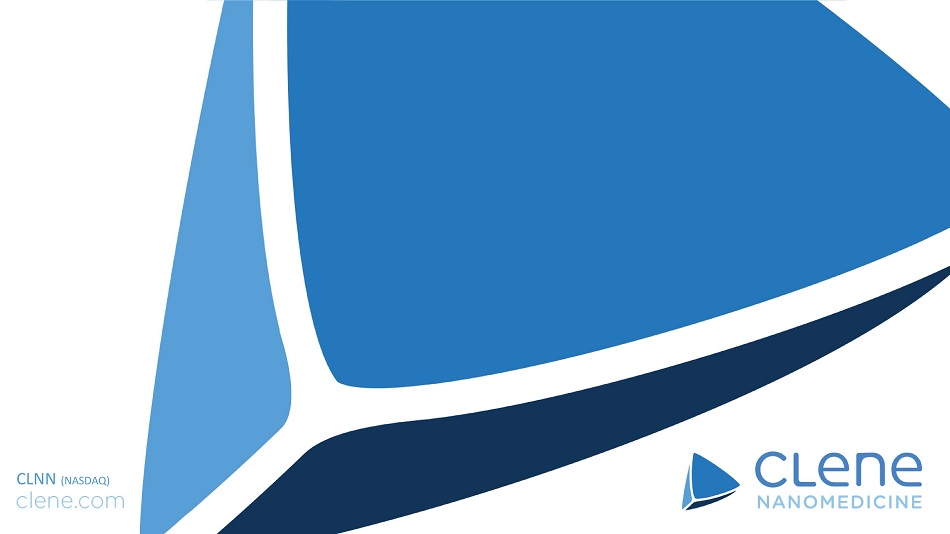
CLNN (NASDAQ)
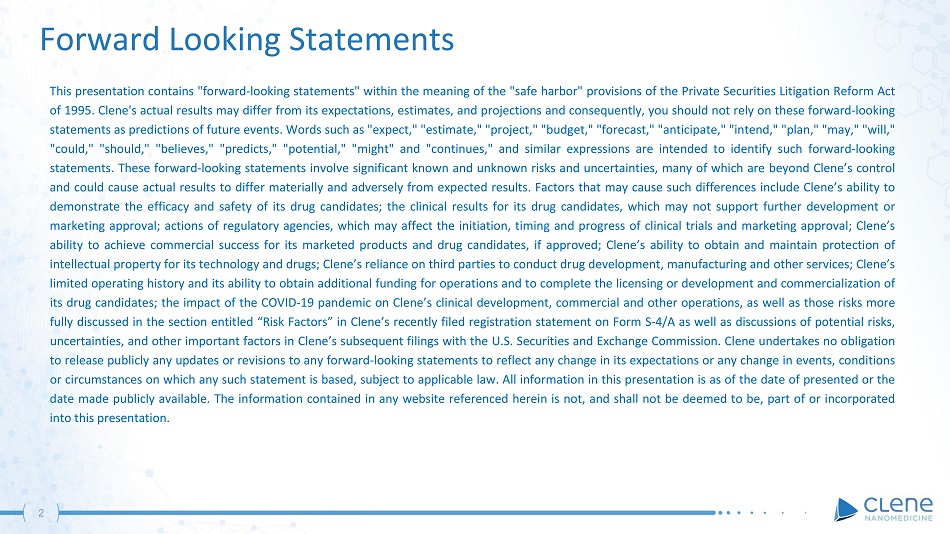
Forward Looking Statements 2 This presentation contains "forward - looking statements" within the meaning of the "safe harbor" provisions of the Private Securities Litigation Reform Act of 1995 . Clene's actual results may differ from its expectations, estimates, and projections and consequently, you should not rely on these forward - looking statements as predictions of future events . Words such as "expect," "estimate," "project," "budget," "forecast," "anticipate," "intend," "plan," "may," "will," "could," "should," "believes," "predicts," "potential," "might" and "continues," and similar expressions are intended to identify such forward - looking statements . These forward - looking statements involve significant known and unknown risks and uncertainties, many of which are beyond Clene’s control and could cause actual results to differ materially and adversely from expected results . Factors that may cause such differences include Clene’s ability to demonstrate the efficacy and safety of its drug candidates ; the clinical results for its drug candidates, which may not support further development or marketing approval ; actions of regulatory agencies, which may affect the initiation, timing and progress of clinical trials and marketing approval ; Clene’s ability to achieve commercial success for its marketed products and drug candidates, if approved ; Clene’s ability to obtain and maintain protection of intellectual property for its technology and drugs ; Clene’s reliance on third parties to conduct drug development, manufacturing and other services ; Clene’s limited operating history and its ability to obtain additional funding for operations and to complete the licensing or development and commercialization of its drug candidates ; the impact of the COVID - 19 pandemic on Clene’s clinical development, commercial and other operations, as well as those risks more fully discussed in the section entitled “Risk Factors” in Clene’s recently filed registration statement on Form S - 4 /A as well as discussions of potential risks, uncertainties, and other important factors in Clene’s subsequent filings with the U . S . Securities and Exchange Commission . Clene undertakes no obligation to release publicly any updates or revisions to any forward - looking statements to reflect any change in its expectations or any change in events, conditions or circumstances on which any such statement is based, subject to applicable law . All information in this presentation is as of the date of presented or the date made publicly available . The information contained in any website referenced herein is not, and shall not be deemed to be, part of or incorporated into this presentation .

L a nx id e C o rp o r a ti on Dupont Lanxide Composites Lanxide Armor Company Lanxide Performance Materials Lanxide Electronic Components CDO CLENE | Management Team Ted Jeong , DM 3
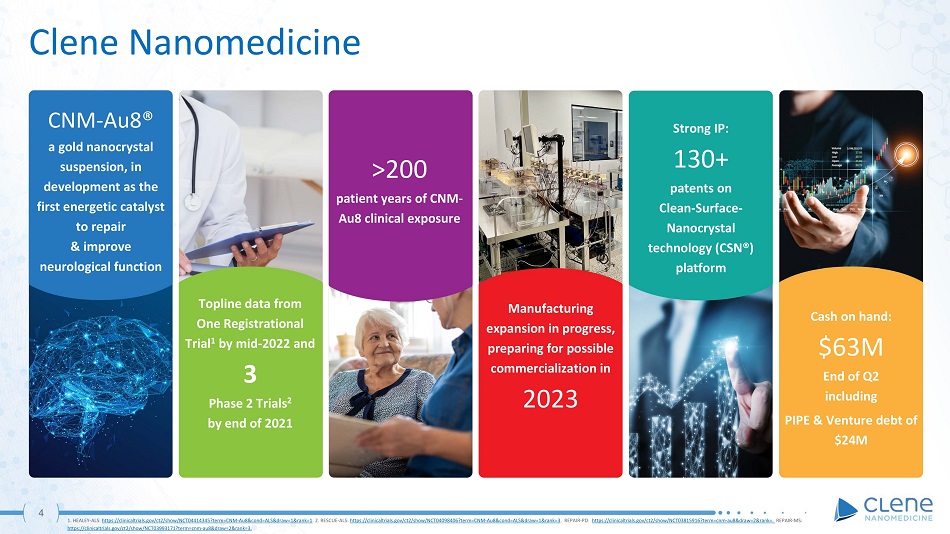
4 Clene Nanomedicine Cash on hand: $63M End of Q2 including PIPE & Venture debt of $24M Topline data from One Registrational Trial 1 by mid - 2022 and 3 Phase 2 Trials 2 by end of 2021 >200 patient years of CNM - Au8 clinical exposure CNM - Au8® a gold nanocrystal suspension, in development as the first energetic catalyst to repair & improve neurological function Manufacturing expansion in progress, preparing for possible commercialization in 2023 Strong IP: 130+ patents on Cle an - Su r fa c e - Nanocrystal technology (CSN®) platform 1. HEALEY - ALS: https://clinicaltrials.gov/ct2/show/NCT04414345?term=CNM - Au8&cond=ALS&draw=1&rank=1 . 2. RESCUE - ALS: https://clinicaltrials.gov/ct2/show/NCT04098406?term=CNM - Au8&cond=ALS&draw=1&rank=3 . REPAIR - PD: https://clinicaltrials.gov/ct2/show/NCT03815916?term=cnm - au8&draw=2&rank=. REPAIR - MS: https://clinicaltrials.gov/ct2/show/NCT03993171?term=cnm - au8&draw=2&rank=3.
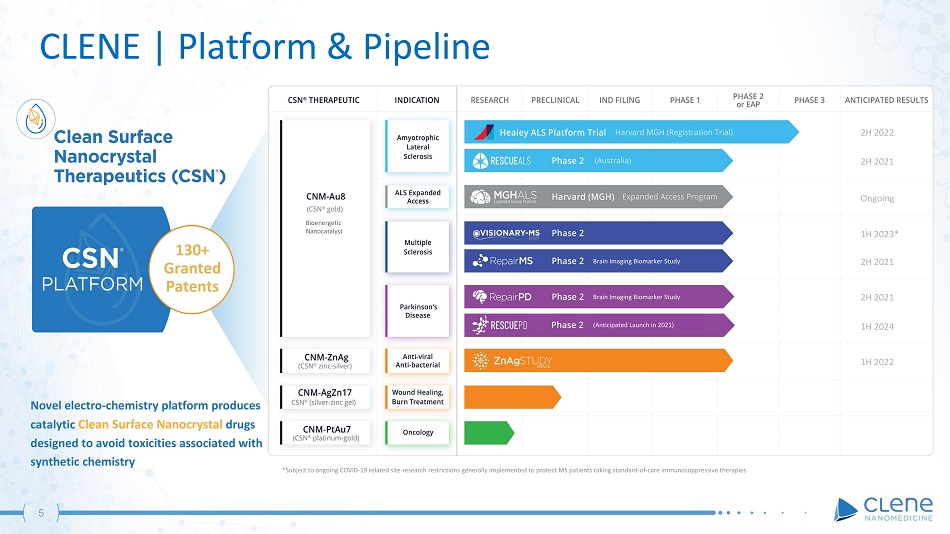
Novel electro - chemistry platform produces catalytic Clean Surface Nanocrystal drugs designed to avoid toxicities associated with synthetic chemistry 130+ G ra n ted Patents CLENE | Platform & Pipeline (Anticipated Launch in 2021) Brain Imaging Biomarker Study Brain Imaging Biomarker Study 2H 2022 2H 2021 O ngo i ng 5 1H 2023* 2H 2021 2H 2021 1H 2024 1H 2022 *Subject to ongoing COVID - 19 related site research restrictions generally implemented to protect MS patients taking standard - of - care immunosuppressive therapies Bioenergetic N a n oca t a l yst
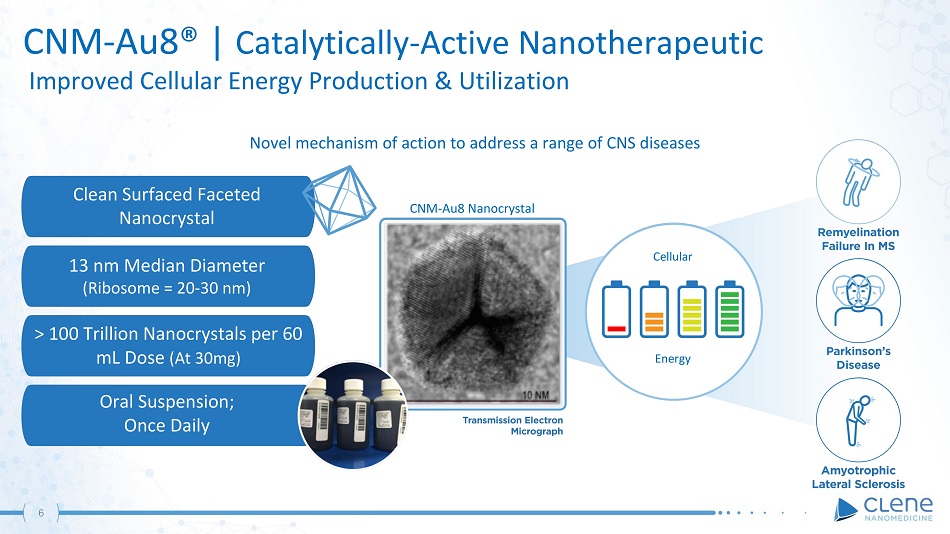
CNM - Au8® | Catalytically - Active Nanotherapeutic Improved Cellular Energy Production & Utilization Energy Oral Suspension; Once Daily > 100 Trillion Nanocrystals per 60 mL Dose (At 30mg) 13 nm Median Diameter (Ribosome = 20 - 30 nm) Clean Surfaced Faceted Nanocrystal Novel mechanism of action to address a range of CNS diseases CNM - Au8 Nanocrystal Cellular 6
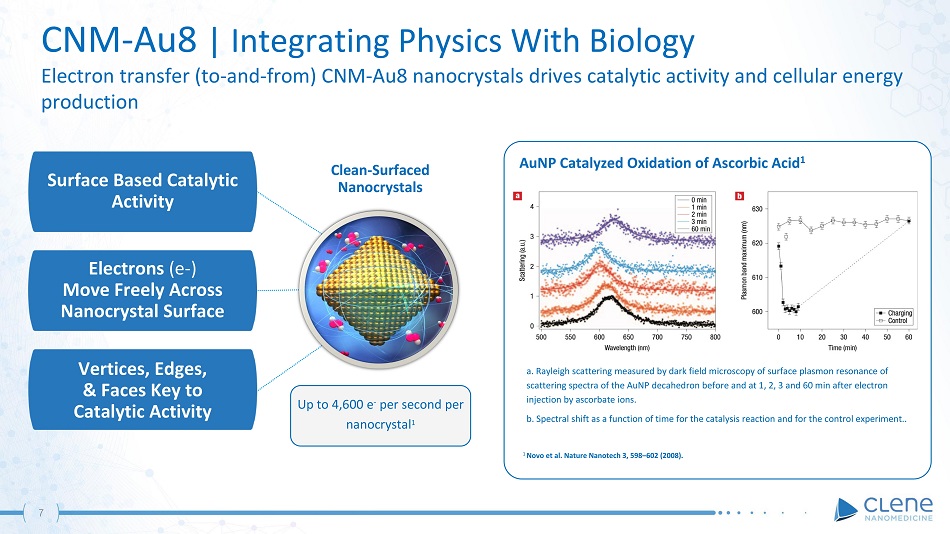
CNM - Au8 | Integrating Physics With Biology Electron transfer (to - and - from) CNM - Au8 nanocrystals drives catalytic activity and cellular energy production Surface Based Catalytic Activity Electrons (e - ) Move Freely Across Nanocrystal Surface Vertices, Edges, & Faces Key to Catalytic Activity AuNP Catalyzed Oxidation of Ascorbic Acid 1 a . Rayleigh scattering measured by dark field microscopy of surface plasmon resonance of scattering spectra of the AuNP decahedron before and at 1 , 2 , 3 and 60 min after electron injection by ascorbate ions . b. Spectral shift as a function of time for the catalysis reaction and for the control experiment.. 1 Novo et al. Nature Nanotech 3, 598 – 602 (2008). Clea n - Surf aced Nanocrystals Up to 4,600 e - per second per nanocrystal 1 7

Treating Energetic Failure | Common Pathological Mechanism In Neurodegenerative Disorders (MS, ALS, PD) Respiratory Insuff ic ie n cy Dysphag i a/ Dysarthria Cognitive Impa irment Muscle Weakness/Atrophy ALS Neuronal Metabolic Failure MS Oligodendrocyte Remyelination Failure and Neuronal Die - Off Vandoorne et al. Acta Neuropathologica (2018) 135:489 – 509. Rone et al. J Neurosci. 2016 Apr 27;36(17):4698 - 707. Cognitive Impa irment Spinal Cord (Move m e n t) Dexterity & C oor din a t io n Visual Impairment Neu r on Act iv ated A s t r ocyte Demyelination Oligodendrocyte Mye li n She ath Comp r om is ed Axon Dendritic Ret r act i on Neuromuscular Junction Impairment Ac t iva te d A st rocy t e 8

CNM - Au8 | MOA Therapeutic Effects a Nicotinamide Adenine Dinucleotide a 9
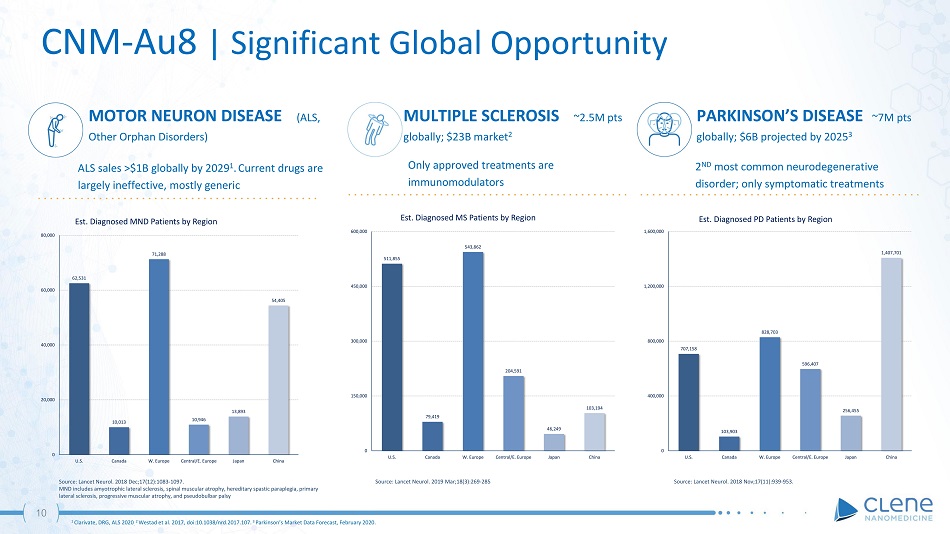
1 0 CNM - Au8 | Significant Global Opportunity 707,158 103,903 828,703 596,407 256,455 1,407,7 0 1 0 400,000 800,000 1,200,000 1,600,000 U.S. Can ada W . E u ro pe Central/E. Europe J ap an China Est. Diagnosed PD Patients by Region Source: Lancet Neurol. 2018 Nov;17(11):939 - 953. ~7M pts PARKINSON’S DISEASE globally; $6B projected by 2025 3 2 ND most common neurodegenerative disorder; only symptomatic treatments 62,531 10,013 71,288 10,946 13,893 54,405 0 2 0,0 00 4 0,0 00 6 0,0 00 8 0,0 00 U.S. Can ada W . E u ro pe Central/E. Europe J ap an China Est. Diagnosed MND Patients by Region Source: Lancet Neurol. 2018 Dec;17(12):1083 - 1097. MND includes amyotrophic lateral sclerosis, spinal muscular atrophy, hereditary spastic paraplegia, primary lateral sclerosis, progressive muscular atrophy, and pseudobulbar palsy (AL S, MOTOR NEURON DISEASE Other Orphan Disorders) ALS sales >$1B globally by 2029 1 . Current drugs are largely ineffective, mostly generic Source: Lancet Neurol. 2019 Mar;18(3):269 - 285 511,855 79,419 543,862 204,591 46,249 103,194 0 150,000 300,000 450,000 600,000 U.S. Can ada W . E u ro pe Central/E. Europe J ap an China Est. Diagnosed MS Patients by Region ~2.5M pts MULTIPLE SCLEROSIS globally; $23B market 2 Only approved treatments are immunomodulators 1 Clarivate, DRG, ALS 2020 . 2 Westad et al. 2017, doi:10.1038/nrd.2017.107. 3 Parkinson’s Market Data Forecast, February 2020.

1 1 1 1 Robinson et al. Sci Rep. 2020, DOI: 10.1038/s41598 - 020 - 58709 - w. . 2 Ho et al. Society for Neuroscience Meeting, 2019. Ho et al. Motor Neuron Disease Associating Meeting, 2019. Data on File, Clene Nanomedicine, Inc. 2 CNM - Au8 | Evidence for Energetic Improvement Therapeutic Activity Across Remyelination + Neuroprotection Models
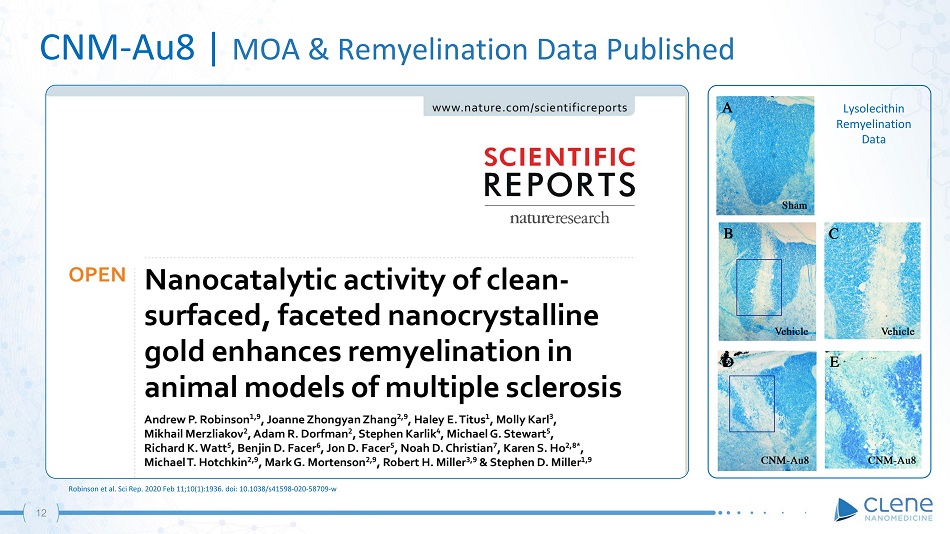
Robinson et al. Sci Rep. 2020 Feb 11;10(1):1936. doi: 10.1038/s41598 - 020 - 58709 - w Lysolecithin Re my e l i n atio n Data CNM - Au8 | MOA & Remyelination Data Published 12
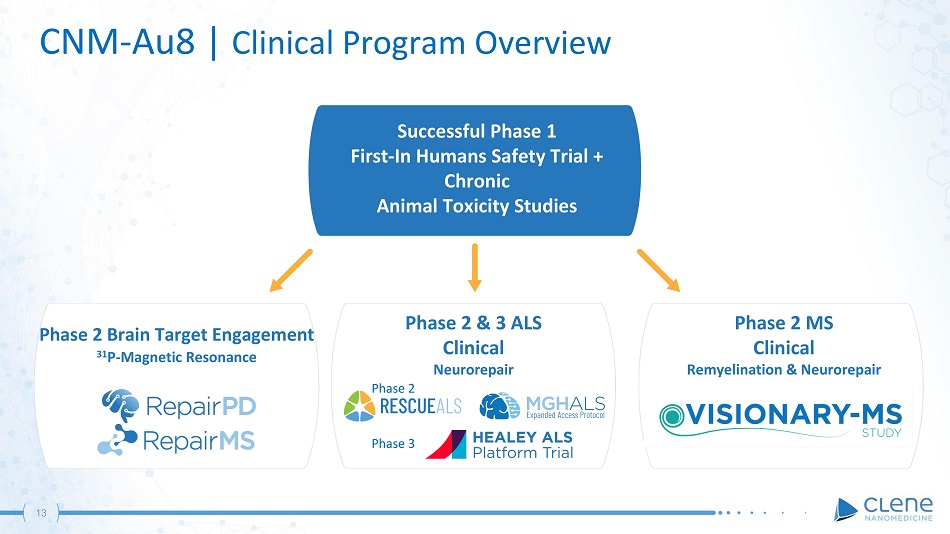
Successful Phase 1 First - In Humans Safety Trial + Chronic Animal Toxicity Studies Phase 2 Brain Target Engagement 31 P - Magnetic Resonance Phase 2 MS Clinical Remyelination & Neurorepair CNM - Au8 | Clinical Program Overview Phase 3 Phase 2 & 3 ALS Clinical Neurorepair Phase 2 13

Genotoxicity In Vitro & In Vivo (Rodent) Safety Pharmacology CNS, CV, Renal Dose Range Finding Rodent, Minipig Single Dose Toxicokinetics Canine Multi - Dose To x icoki neti cs Canine (7 - Day) MTD Toxicokinetics Canine (4 - Wk) Max Feasible To x icoki neti cs Rodent (1 - Wk, SQ) Max Feasible To x icoki neti cs Canine (3 - Wk) Chronic Toxicity Rodent Rodent (6 - Month) Chronic Toxicity Canine Canine (9 - Month) High Dose To x icoki neti cs Rodent (3 - Wk) a No Adverse Event Level (NOAEL) findings Carcinogenicity Dose Range Finding rasH2 (1 - Month) 14 CNM - Au8 | Clean Toxicology Findings All Studies Resulted in No Adverse Effect Level (NOAEL) a Standard ICH M3(R2) Toxicology Program

• Single - ascending dose – 4 cohorts of 8 subjects plus one repeat (n=40) – 15, 30, 60, 90 mg – 3:1 randomized (active:control) – 1 dose; 17 - day follow - up • Most frequent TEAEs by System Organ Class: Nervous/GI - Nearly all of the TEAEs were Grade 1 severity (mild) • No serious TEAEs, TEAEs leading to discontinuation of treatment, or TEAEs considered severe, life - threatening, or resulting in death • No dose responsive TEAEs observed in SAD or MAD • Multi - ascending dose – 4 cohorts of ~12 subjects (n=46) – 15, 30, 60, 90 mg – 3:1 randomized (active:control) – 21 days daily dosing + follow - up (Up to 50 days) Phase 1 First In Human Study Completed (n=86) >200 Years of Human Exposure CNM - Au8 | Well Tolerated; No Dose - Limiting Safety Issues + Long - Term Extension 15 + Long - Term Extension + Long - Term Extension >90 Weeks Exposure in Clinical Trials; >100 Weeks in ALS Expanded Access
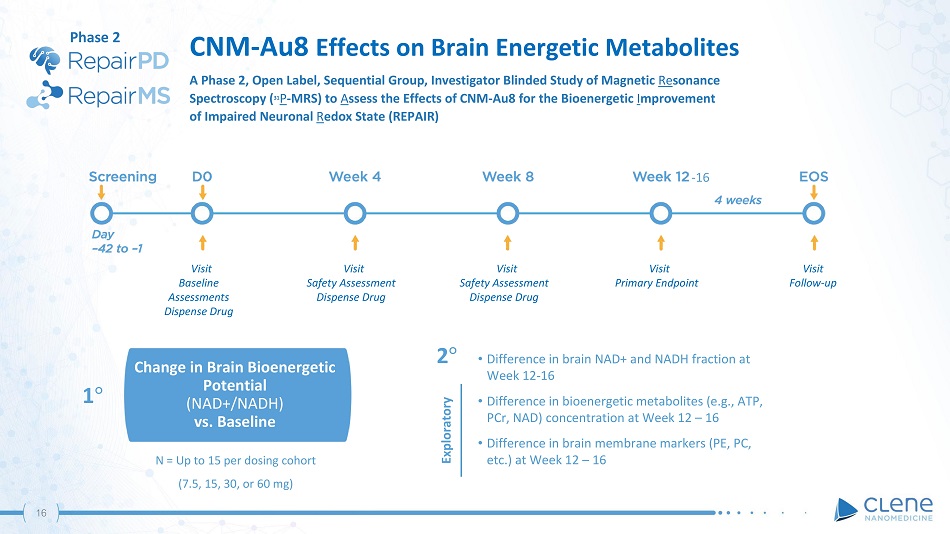
• Difference in brain NAD+ and NADH fraction at Week 12 - 16 • Difference in bioenergetic metabolites (e.g., ATP, PCr, NAD) concentration at Week 12 – 16 • Difference in brain membrane markers (PE, PC, etc.) at Week 12 – 16 Change in Brain Bioenergetic Potential (NAD+/NADH) vs. Baseline 1 ι 2 ι CNM - Au8 Effects on Brain Energetic Metabolites A Phase 2, Open Label, Sequential Group, Investigator Blinded Study of Magnetic Re sonance Spectr osco py ( 31 P - MRS) to A sses s the Eff ect s of C N M - Au8 for the Bi oenergeti c I mpr o ve m ent of Impaired Neuronal R edox State (REPAIR) Visit Safety Assessment Dispense Drug Visit Safety Assessment Dispense Drug Visit Primary Endpoint Visit F ollo w - up Visit Baseline Ass e ssmen t s Dispense Drug - 16 N = Up to 15 per dosing cohort (7.5, 15, 30, or 60 mg) Phase 2 Exploratory 16

NAD + /NADH | Age Related Decline of Brain Energy Metabolism (By 31 P - MRS Imaging) Closed squares = averaged data by age group: 21 – 26 yrs, 33 – 36 yrs, and 59 – 68 yrs old; Open squares= individual subject values ~0.5% NAD + /NADH unit decline per decade (~0.13 mV units per year) 17 Zhu et al. Proc Natl Acad Sci USA . 2015 Mar 3;112(9):2876 - 81. NAD + Declines / NADH Increases (Aging Change by Decade)
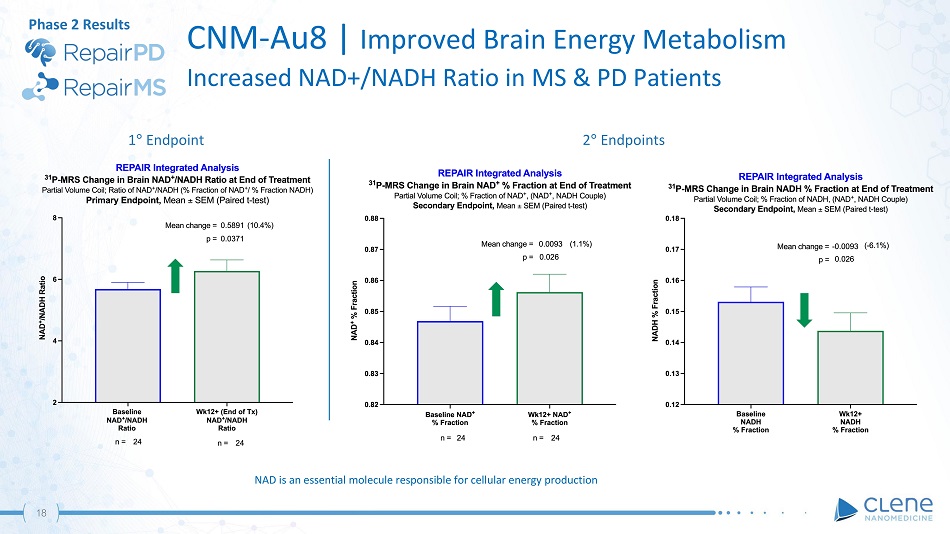
CNM - Au8 | Improved Brain Energy Metabolism Increased NAD+/NADH Ratio in MS & PD Patients Phase 2 Results 18 1 ƒ Endpoint 2 ƒ Endpoints NAD is an essential molecule responsible for cellular energy production
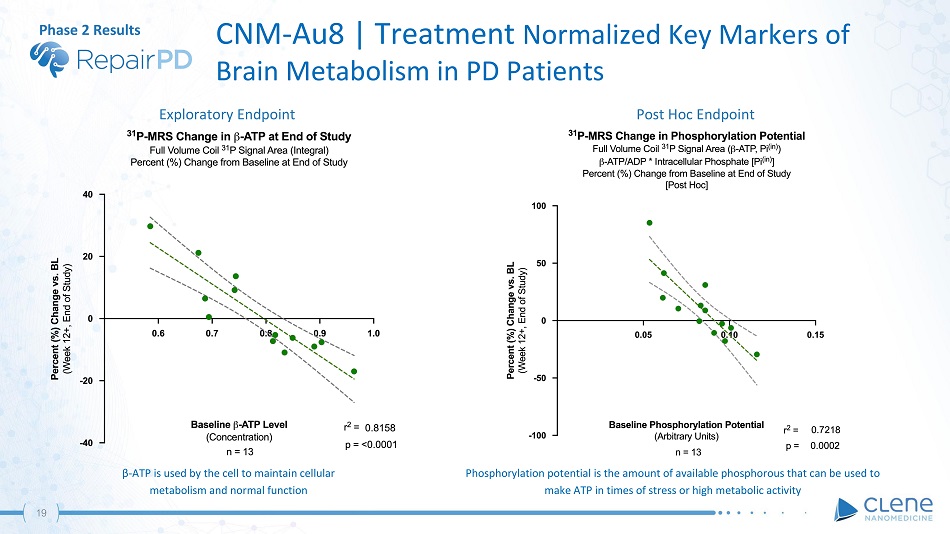
β - ATP is used by the cell to maintain cellular metabolism and normal function Phosphorylation potential is the amount of available phosphorous that can be used to make ATP in times of stress or high metabolic activity CNM - Au8 | Treatment Normalized Key Markers of Brain Metabolism in PD Patients Phase 2 Results Exploratory Endpoint Post Hoc Endpoint 19

(January 2020); FPFV 16 - Jan - 2020; 45 of 42 enrolled (Nov - 2020) Phase 2 Anticipated full unblinded data readout: 2H 2021 Exploratory Endpoints • Other Electromyography (SH i, NP i, MUSIX, MScan) • ALSFRS - R • Change in Rate of ALSFRS - R progression • QOL • Combined Joint - Rank (Survival + ALSFRS - R) Change in Sum of Motor Unit Index For the Abductor Digiti Minimi (ADM), Abductor Pollicis Brevis (APB), Biceps Brachii (BB), Tibialis Anterior (TA) 1 ι Key Secondary: Forced Vital Capacity 2 ι 20

Predictive Endpoints of Disease Progression Clinical Endpo i nts • ALSFRS - R • Pulmonary Function (Vital Capacity) • Mortality • Loss of Motor Units Motor Unit Index (MUNIX) MUNIX Longitudinal Progression 21 Electromyography | Sensitive Biomarker Predictive of Clinical Progression
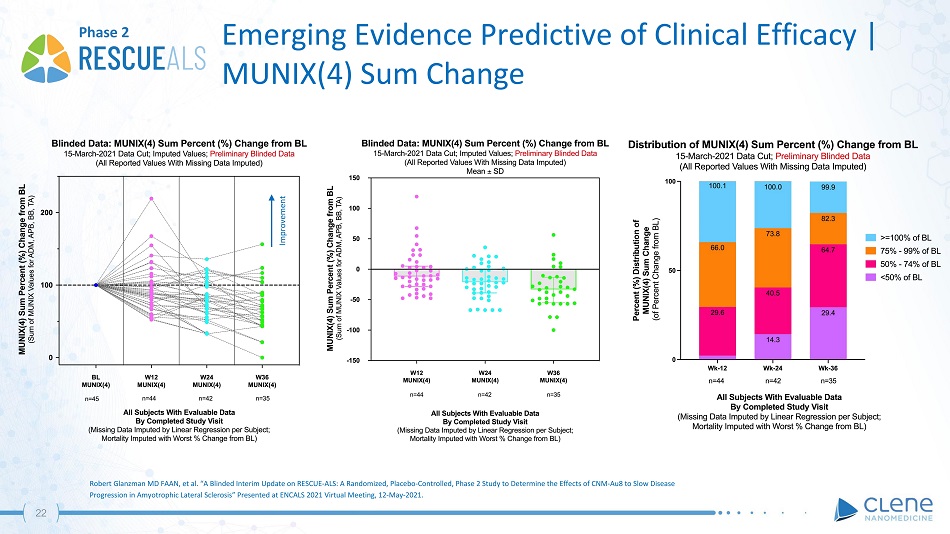
Phase 2 Improv e m e nt Emerging Evidence Predictive of Clinical Efficacy | MUNIX(4) Sum Change Robert Glanzman MD FAAN, et al. “A Blinded Interim Update on RESCUE - ALS: A Randomized, Placebo - Controlled, Phase 2 Study to Determine the Effects of CNM - Au8 to Slow Disease Progression in Amyotrophic Lateral Sclerosis” Presented at ENCALS 2021 Virtual Meeting, 12 - May - 2021. 22
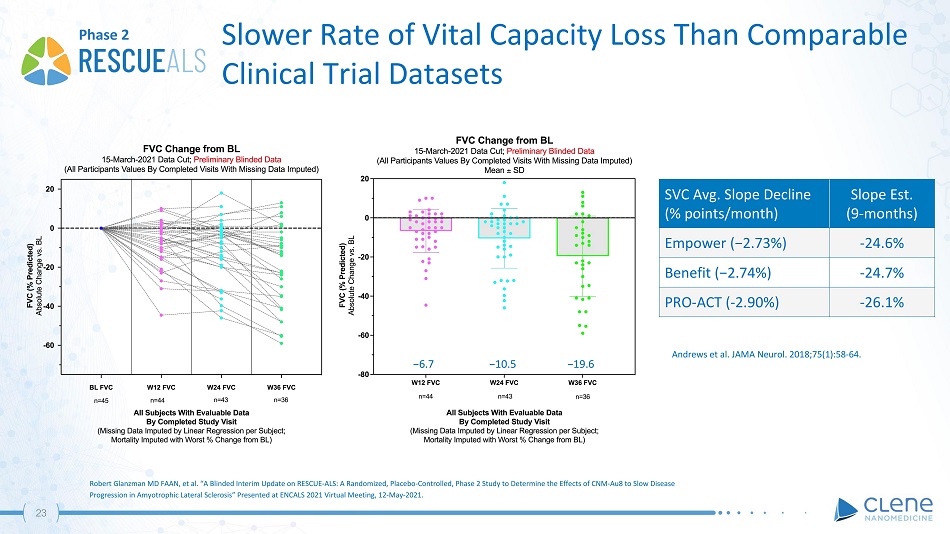
SVC Avg. Slope Decline (% points/month) Slope Est. (9 - mon t h s) Empower (−2.73%) - 24.6% Benefit (−2.74%) - 24.7% PRO - ACT ( - 2.90%) - 26.1% − 10.5 − 19.6 − 6.7 Andrews et al. JAMA Neurol. 2018;75(1):58 - 64. Phase 2 Robert Glanzman MD FAAN, et al. “A Blinded Interim Update on RESCUE - ALS: A Randomized, Placebo - Controlled, Phase 2 Study to Determine the Effects of CNM - Au8 to Slow Disease Progression in Amyotrophic Lateral Sclerosis” Presented at ENCALS 2021 Virtual Meeting, 12 - May - 2021. 23 Slower Rate of Vital Capacity Loss Than Comparable Clinical Trial Datasets
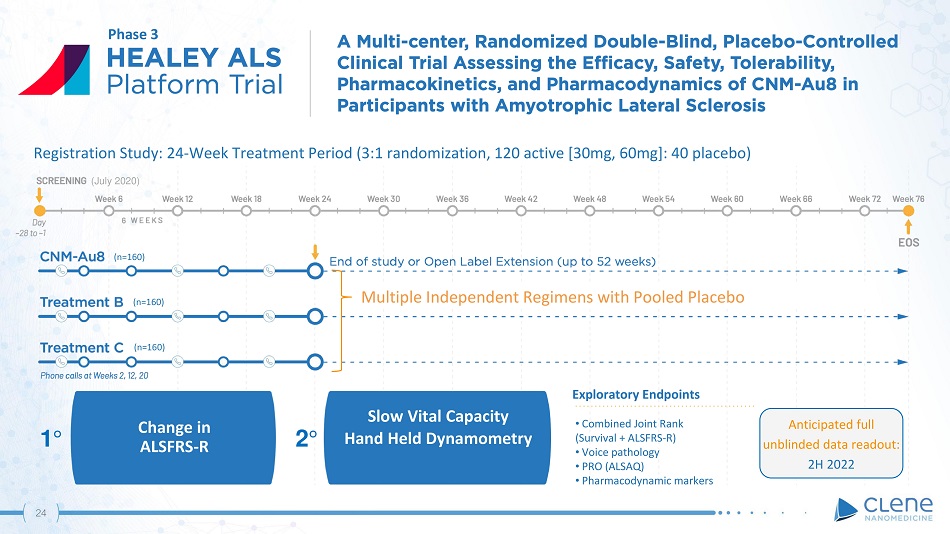
Exploratory Endpoints • Combined Joint Rank (Survival + ALSFRS - R) • Voice pathology • PRO (ALSAQ) • Pharmacodynamic markers Slow Vital Capacity Hand Held Dynamometry Change in ALSFRS - R Registration Study: 24 - Week Treatment Period (3:1 randomization, 120 active [30mg, 60mg]: 40 placebo) (July 2020) 24 (n=16 0) (n=16 0) (n=16 0) 1 ι 2 ι Phase 3 Multiple Independent Regimens with Pooled Placebo Anticipated full unblinded data readout: 2H 2022

2 5 Exploratory Endpoints Treatment of Vis ual Pathway Deficits I n Chronic O ptic N europathy for A ssessment of R em y elination in Non - Active Relapsing MS Change in Low Contrast Letter Acuity (LCLA) At Week 24 Up to 48 - Week Placebo - Control 2:1 Randomization (Active: Placebo ) 15mg, 30mg, Placebo (n=150) • Optical Coherence Tomography (OCT) • Multi - focal VEP Amplitude & Latency • Full field - VEP Amplitude & Latency • MRI Endpoints • Visual Function (High Contrast) • QOL / EDSS 1 ι 2 ι Change Composite Clinical Response 9HPT / SDMT / T25FW / LCLA / EDSS Phase 2 - 42 to - 1 24 - Week Blinded Fixed Treatment Period Up to 24 - Week Blinded Extension Period (Until LPLV 24Wk Visit) L P LV Anticipated top - line unblinded data: 1H 2023* *Subject to ongoing COVID - 19 related site research restrictions generally implemented to protect MS patients taking standard - of - care immunosuppressive therapies
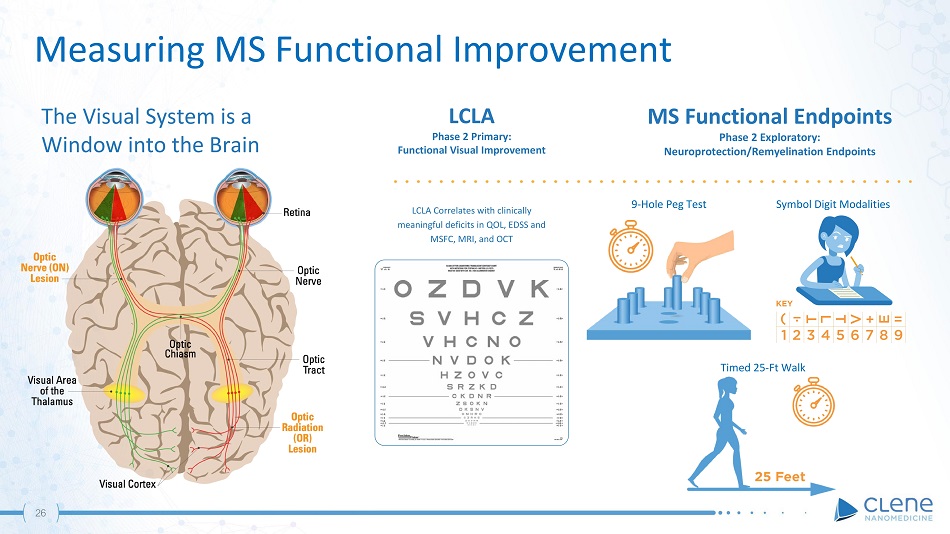
LCLA Phase 2 Primary: Functional Visual Improvement LCLA Correlates with clinically meaningful deficits in QOL, EDSS and MSFC, MRI, and OCT MS Functional Endpoints Phase 2 Exploratory: Neuroprotection/Remyelination Endpoints The Visual System is a Window into the Brain 9 - Hole Peg Test 26 Symbol Digit Modalities Timed 25 - Ft Walk Measuring MS Functional Improvement
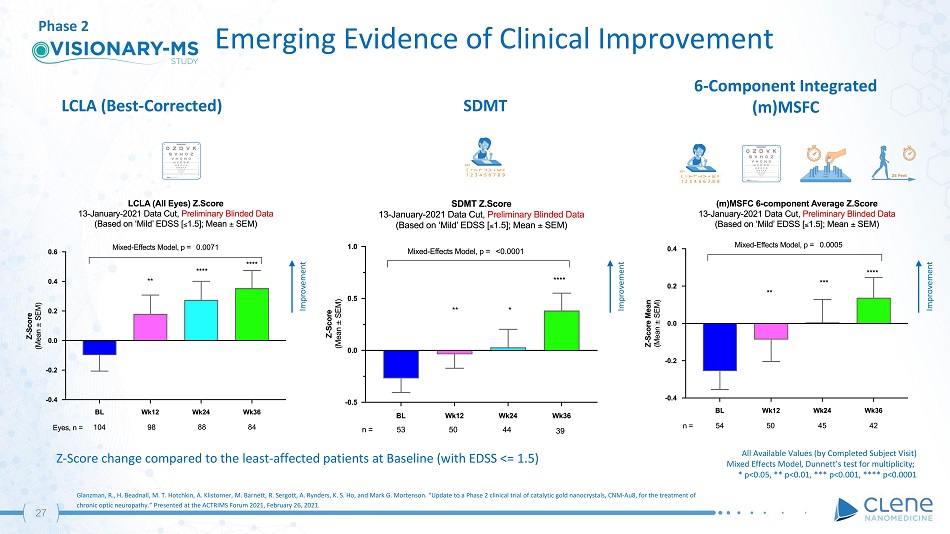
Emerging Evidence of Clinical Improvement Glanzman, R., H. Beadnall, M. T. Hotchkin, A. Klistorner, M. Barnett, R. Sergott, A. Rynders, K. S. Ho, and Mark G. Mortenson. “Update to a Phase 2 clinical trial of catalytic gold nanocrystals, CNM - Au8, for the treatment of chronic optic neuropathy.” Presented at the ACTRIMS Forum 2021, February 26, 2021. LCLA ( Bes t - Corrected) SDMT 6 - Component Integrated (m)MSFC Phase 2 Improv e m e nt Improv e m e nt Improv e m e nt Z - Score change compared to the least - affected patients at Baseline (with EDSS <= 1.5) 27 All Available Values (by Completed Subject Visit) Mixed Effects Model, Dunnett’s test for multiplicity; * p<0.05, ** p<0.01, *** p<0.001, **** p<0.0001

CS N 28 ® Clean surface nanocrystal (CSN) therapeutics Issued & Allowed Patents 130+ Pending Applications >30 Total Patents/ Applications >160 Process And Method/Device (Clean Surface; Gold CSN) State of Matter (CNM - Au8) Method of Use (Prevent Demyelination & MoA) Method of Use (Bi - Metallic Au/Pt; Antimicrobial) Plasma Cond i t i on i n g Electrode Design & Cycling Trough Flow, Temp, Pressure Concentration & Filtration Strong Intellectual Property Extensive Patent Portfolio With Protection Through 2035 a & Proprietary Trade Secrets; Plus 7 - year Orphan Drug Designation Patent Status Patent Description Trade Secrets a With Patent Restoration Term (assuming 5 - year extension).
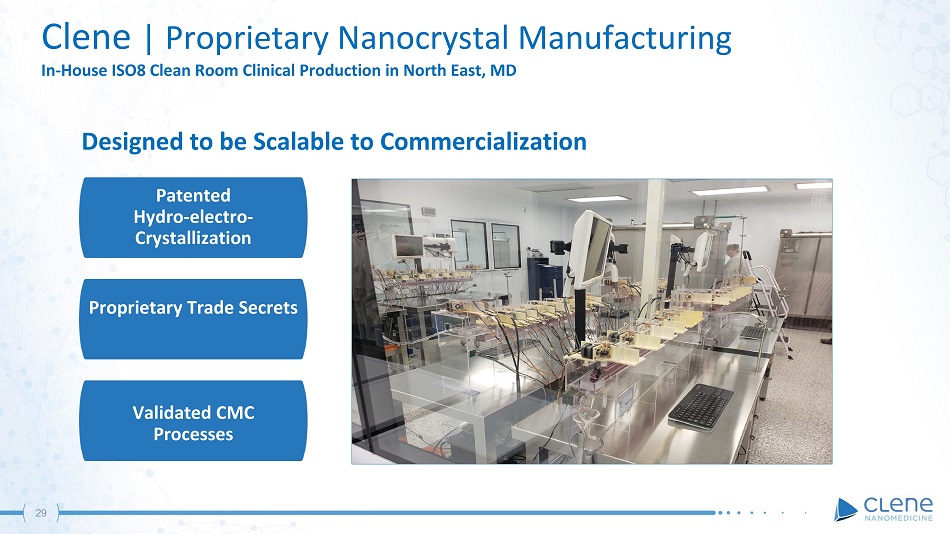
Clene | Proprietary Nanocrystal Manufacturing In - House ISO8 Clean Room Clinical Production in North East, MD Validated CMC Processes 29 Designed to be Scalable to Commercialization Patented Hydro - ele ctro - Crystallization Proprietary Trade Secrets

Anticipated Timeline & Investor Catalysts 2020 - 2023 30

Unmet Medical Need & Market Opportunity Lead Asset: CNM - Au8 for Neuro Repair Clinical Development Pipeline Strong IP Portfolio Financials CNM - ZnAg for COVID - 19 CLENE | Investment Highlights • Energy enhancing nanotherapeutic • Robust Preclinical Remyelination & Neuroprotection Data Across Multiple Animal Models in: MS, ALS, and Parkinson’s Disease • NOAEL Findings From All Toxicity Studies • Acceptable Phase 1 Safety Profile • >90 Weeks Exposure in Clinical Trials; >100 Weeks in ALS Expanded Access (EAP) • Two Phase 2 Brain Target Engagement Studies in PD and MS with Top Line Results Reported Aug 2021 • Three Phase 2 POC Studies in ALS, MS, and COVID with Results Anticipated in the next 12 - 18 Months • Phase 3 ALS Registrational Trial in with Full Results Anticipated in mid - 2022 • Ongoing ALS Early Access Program • USA FDA Granted ALS Orphan Drug Designation • CLNN (NASDAQ) • $31.9M USD (Gross) Raised via SPAC merger + PIPE (2020) • Cash on Hand at end of Q2 2021 of $63.0M (Unaudited) • Anticipated Cash Runway to EOY 2022 • $114M USD Raised Privately (Series A - D) • +$16.7M in Additional Grant and Indirect Financial Support for ALS and MS Phase 2 & 3 Clinical Programs • $ 24 . 3 M USD (Gross) Raised via PIPE + Venture debt for MFG ( 2021 ) • Zinc - Silver Antiviral + Immune Support • Phase 2 Trial in Brazil To Treat Acutely Symptomatic Non - Hospitalized COVID - 19 Patients Underway 1st Endpoint: Prevention of Hospitalization Time to 31 1 Data on file, Clene Nanomedicine, Inc. ( Up 2nd Endpoint: Symptomatic Improvement to 28 Days) • Results Anticipated 1H 2022 • 130+ Issued Patents Worldwide; 30+ Pending Patent Applications • State of Matter Claims Cover Myelin Protection Mechanisms, Remyelination, and Neuroprotection to 2035 (with Patent Restoration Term) • Manufacturing Device and Process Patents to 2030 and Beyond • No Effective Disease - Modifying Drugs for ALS or PD • No MS Therapies Clinically Impact Remyelination & Neurorepair • Remyelination and Neurorepair Sales Could Exceed $10B per annum 1 ALS is a Lethal Motor Neuron Disease With Suboptimal Therapies PD is Highly Prevalent With No Disease Modifying Treatments

Clene Inc. HQ & Clinical Development 6550 South Millrock Drive, Suite G50 Salt Lake City, UT 84121 R&D and Manufacturing 500 Principio Parkway, Suite 400 North East, MD 21901 © 2021 Clene Inc. Version: 16 - September - 2021
Serious News for Serious Traders! Try StreetInsider.com Premium Free!
You May Also Be Interested In
- Form 8.5 (EPT/RI) - musicMagpie Plc
- Spar Nord repays Tier 2 capital with ISINs DK0030431341 and DK0030432075
- Alphabet stock surges 11% to record high on Q1 earnings beat, first-ever dividend
Create E-mail Alert Related Categories
SEC FilingsSign up for StreetInsider Free!
Receive full access to all new and archived articles, unlimited portfolio tracking, e-mail alerts, custom newswires and RSS feeds - and more!



 Tweet
Tweet Share
Share